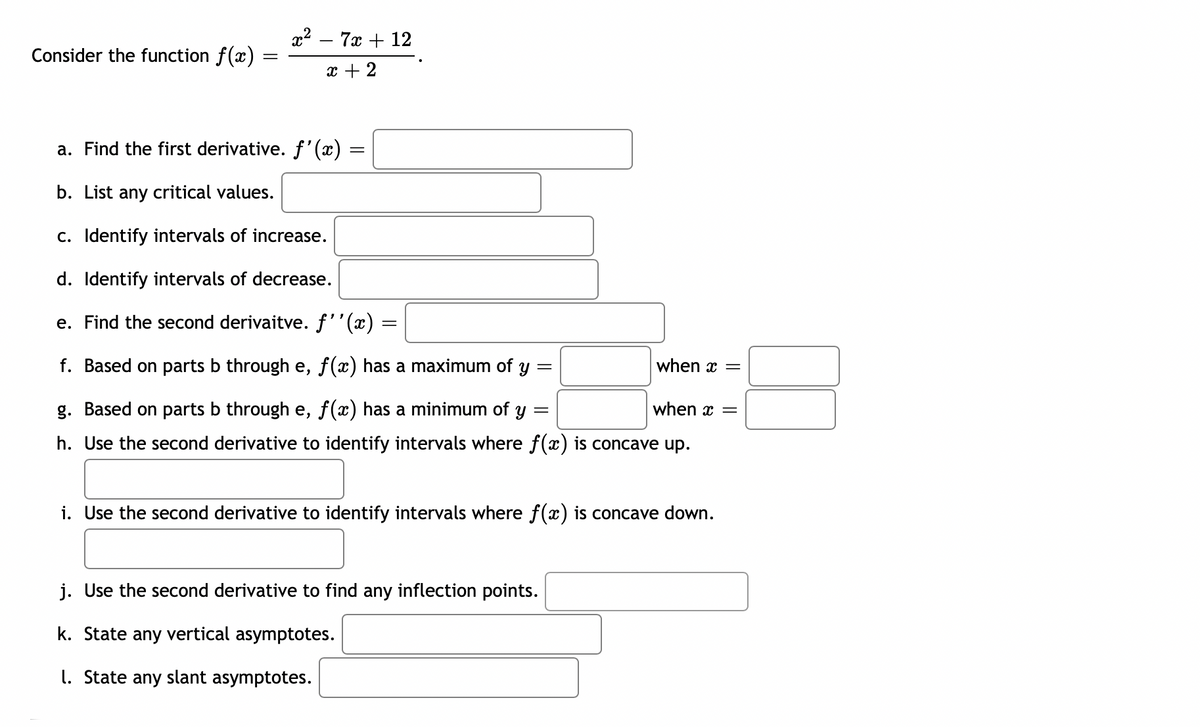Consider the function f(x) x² - 7x + 12 x + 2 a. Find the first derivative. f'(x): b. List any critical values. c. Identify intervals of increase. d. Identify intervals of decrease. e. Find the second derivaitve. f''(x) = = f. Based on parts b through e, f(x) has a maximum of y = when x = g. Based on parts b through e, f(x) has a minimum of y = h. Use the second derivative to identify intervals where f(x) is concave up. when x = i. Use the second derivative to identify intervals where f(x) is concave down. j. Use the second derivative to find any inflection points. k. State any vertical asymptotes. 1. State any slant asymptotes.
Consider the function f(x) x² - 7x + 12 x + 2 a. Find the first derivative. f'(x): b. List any critical values. c. Identify intervals of increase. d. Identify intervals of decrease. e. Find the second derivaitve. f''(x) = = f. Based on parts b through e, f(x) has a maximum of y = when x = g. Based on parts b through e, f(x) has a minimum of y = h. Use the second derivative to identify intervals where f(x) is concave up. when x = i. Use the second derivative to identify intervals where f(x) is concave down. j. Use the second derivative to find any inflection points. k. State any vertical asymptotes. 1. State any slant asymptotes.
Functions and Change: A Modeling Approach to College Algebra (MindTap Course List)
6th Edition
ISBN:9781337111348
Author:Bruce Crauder, Benny Evans, Alan Noell
Publisher:Bruce Crauder, Benny Evans, Alan Noell
Chapter1: Functions
Section1.2: Functions Given By Tables
Problem 32SBE: Does a Limiting Value Occur? A rocket ship is flying away from Earth at a constant velocity, and it...
Related questions
Question
Please note this is all one problem.

Transcribed Image Text:7х + 12
Consider the function f(x)
x + 2
a. Find the first derivative. f'(x) =
b. List any critical values.
c. Identify intervals of increase.
d. Identify intervals of decrease.
e. Find the second derivaitve. f''(x) =
f. Based on parts b through e, f(x) has a maximum of y
when x =
g. Based on parts b through e, f(x) has a minimum of y
when x =
h. Use the second derivative to identify intervals where f(x) is concave up.
i. Use the second derivative to identify intervals where f(x) is concave down.
j. Use the second derivative to find any inflection points.
k. State any vertical asymptotes.
l. State any slant asymptotes.
Expert Solution
This question has been solved!
Explore an expertly crafted, step-by-step solution for a thorough understanding of key concepts.
This is a popular solution!
Trending now
This is a popular solution!
Step by step
Solved in 9 steps with 1 images

Recommended textbooks for you

Functions and Change: A Modeling Approach to Coll…
Algebra
ISBN:
9781337111348
Author:
Bruce Crauder, Benny Evans, Alan Noell
Publisher:
Cengage Learning

Algebra & Trigonometry with Analytic Geometry
Algebra
ISBN:
9781133382119
Author:
Swokowski
Publisher:
Cengage


Functions and Change: A Modeling Approach to Coll…
Algebra
ISBN:
9781337111348
Author:
Bruce Crauder, Benny Evans, Alan Noell
Publisher:
Cengage Learning

Algebra & Trigonometry with Analytic Geometry
Algebra
ISBN:
9781133382119
Author:
Swokowski
Publisher:
Cengage
